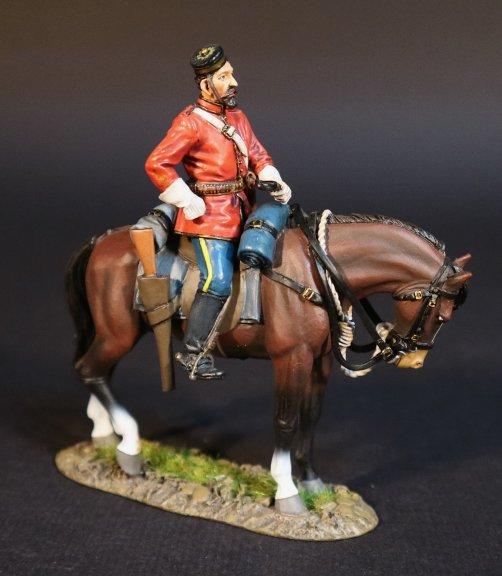Superintendent (Major) James Morrow Walsh, 1877, The North West Mounted Police, The March West, 1874, The Fur Trade--single mounted figure
$108.00
Item Number: WSP-81
Superintendent (Major) James Morrow Walsh, 1877, The North West Mounted Police, The March West, 1874, The Fur Trade
THE NORTH WEST MOUNTED POLICE
THE MARCH WEST
The NWMP was established by the Canadian government during the ministry of Prime Minister Sir John Macdonald who defined its purpose as “the preservation of peace and the prevention of crime” in the vast NWT.
Macdonald’s principal fear was that the activities of American traders which led to the Cypress Hills Massacre would lead to the First nations peoples killing American traders, which would lead to the United States military being deployed into the NWT to protect the lives of American citizens under the grounds that Canada was unable to maintain law and order in the region.
His greatest fear was that if the Americans occupied the NWT that they would not leave and the region would be annexed to the United States.
The NWMP was established in 1873, and were deployed to the area of the present Alberta border. Their ill-planned and arduous journey of nearly 900 miles became known as the March West, and is portrayed as an epic journey of endurance.
Over the next few years, the NWMP established a wide network of forts, posts, and patrols and extended Canadian law across the region. The living conditions of the NWMP on the prairies were spartan and often uncomfortable, and only slowly improved over the course of the century.
James Morrow Walsh (22 May 1840 – 25 July 1905)
Born in Prescott, Ontario, James Walsh was one of the original officers of the NWMP. Superintendent Walsh was assigned in 1875 to establish a post in the Cypress Hills in what is now Saskatchewan. The post was located here because of the 1873 massacre, an atrocity stemming from the illegal American whisky trade.
Walsh’s original role was to shut down this trade, but in June 1876, his position grew in importance when several thousand Sioux crossed the border into Canada, taking refuge there after the Battle of Little Big Horn. Walsh developed a strong friendship with the famous Sioux leader Sitting Bull, and successfully kept peace in the region. Walsh became famous in the American press as “Sitting Bull’s Boss”.
In reality, Walsh’s orders were to convince Sitting Bull and the Sioux to return to the United States, but the Canadian government decided that Walsh’s friendship with Sitting Bull was an obstacle to the Sioux’s return across the border.
In 1880, Walsh was transferred to Fort Qu’Appelle, Saskatchewan, and soon after he reluctantly resigned his commission.
In August 1897 during the height of the Klondike Gold Rush, Walsh was appointed Commissioner of the newly created Yukon Territory. He resigned in 1898, returning to Ontario where he died in 1905.
Mount Walsh, a mountain peak in the Saint Elias Mountains in the Yukon, is named after him.
For those interested in learning more about James Morrow Walsh and Sitting Bull, Ian Anderson’s book “Sitting Bull’s Boss, Above the Medicine Line with James Morrow Walsh” is recommended.
ISBN 1-895811-63-5
Released in FEBRUARY 2024.
